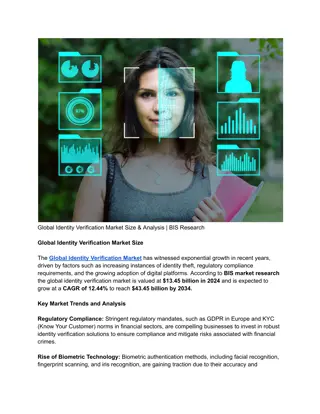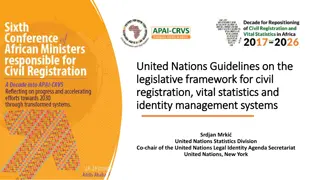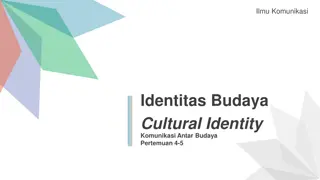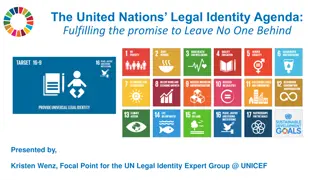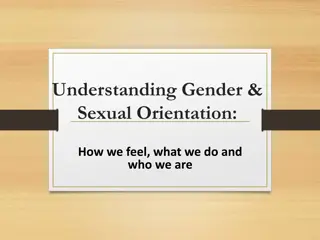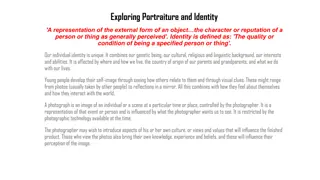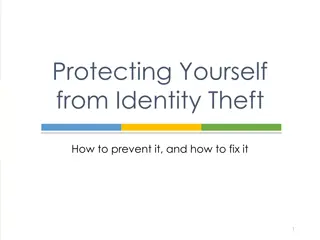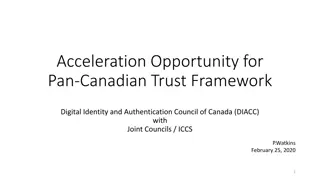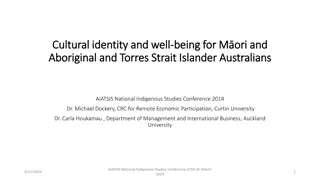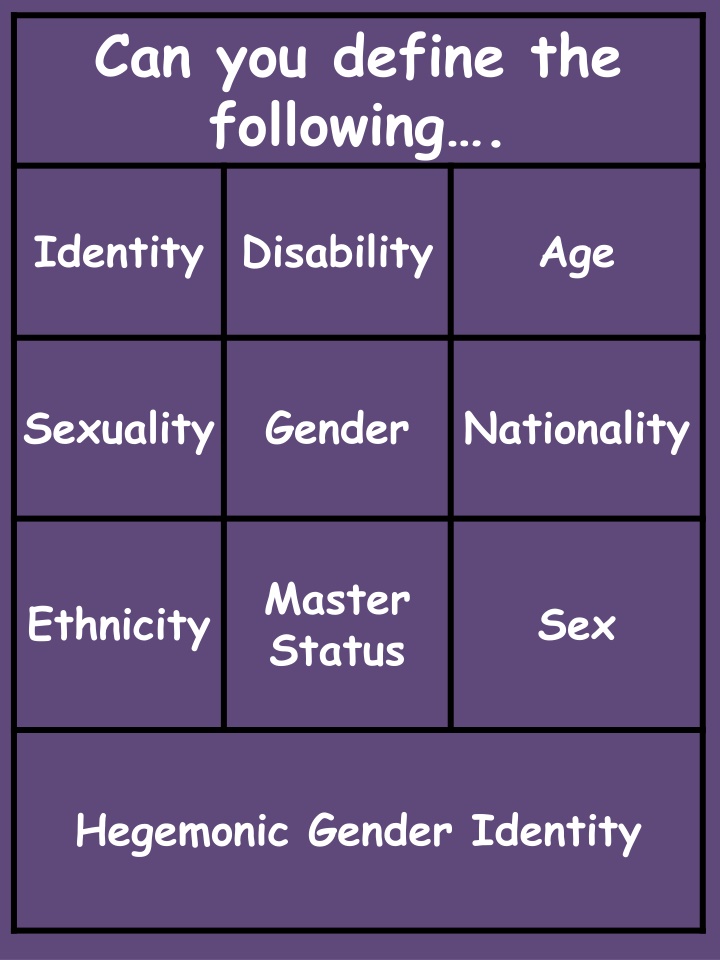
Identity, Disability, Age, Sexuality, Gender, Nationality, and More
Learn about the complex intersections of identity, disability, age, sexuality, gender, and nationality, and how societal perceptions and structures influence individuals' lived experiences. Explore the impact of disability on social interactions, the social model of disability, and the concept of ageism.
Uploaded on | 1 Views
Download Presentation

Please find below an Image/Link to download the presentation.
The content on the website is provided AS IS for your information and personal use only. It may not be sold, licensed, or shared on other websites without obtaining consent from the author. If you encounter any issues during the download, it is possible that the publisher has removed the file from their server.
You are allowed to download the files provided on this website for personal or commercial use, subject to the condition that they are used lawfully. All files are the property of their respective owners.
The content on the website is provided AS IS for your information and personal use only. It may not be sold, licensed, or shared on other websites without obtaining consent from the author.
E N D
Presentation Transcript
Can you define the following . Identity Disability Age Sexuality Gender Nationality Master Status Ethnicity Sex Hegemonic Gender Identity
Disability: a mental/physical impairment which has a substantial and long term effect on an individual's ability to carry out normal day-to day activities e.g. entering a building. Ways in which disability affects life experience: People with disabilities have many factors their identity. These include: which shape work opportunities Stereotyping through Mass Media & Social Attitudes participation in leisure activities. Prejudice & Discrimination perceived status in society. Labelling Disability as the Master Identity verbal/physical abuse/ discrimination. Disability as a Stigmatized Identity. Who is disability significant for? However, things are slowly changing because of the disabled people s movement creating an identity and resistance.
Which two ways can we view disability? Sees disability as a medical problem, focusing on the limitations caused by the impairment. This approach leads to the defining of a disabled person by their disability or impairment. Focuses on the social and physical barriers to inclusion that may exist, such as the design of buildings and public spaces that deny access to those with mobility problems, or discriminatory attitudes and practices against those with disabilities. Society is disabling and disability is socially constructed. Which model is this? Which model is this? Persons who acquire a disability find themselves facing more than just an adjustment to a physical impairment or long term illness which prevents them from walking as fast as other people, from riding horses, or holding a job in competitive employment. They are now regarded by others and even by themselves as being "different" and this difference is considered to be an undesirable one, affecting social interaction with others in such a way as to create a sense of awkwardness, embarrassment and confusion. Birenbaum (1979)
The social model of disability is favoured, as it shows disability is a social construct Disabled people are disabled by society, through things such as; - Negative attitudes - Stereotypes held by able bodied people Disability as a social construct? Disablism occurs- where the identity of those with an impairment is not shaped by the impairment itself, but societies prejudice attitudes. This can be shown in several ways; 1. The mass media - Negative representations - Pity or charity 2. The built environment- little or difficult access 4. Bullying of disabled people- hate crimes. E.g. within care homes 8/10 children with a disability have been bullied in the UK 3. Employers being reluctant to employ those with disabilities Goffman- this can lead to a master status occurring because of their discrimination and bullying- leads to a self-fulfilling prophecy. They internalise and believe negative labels
Age: the length of time a person has lived/an indivudal s lifespan. Ways in which age affects life experience: against because of theirage ageism. (1993) define ageism as the offensive through reference to age . Old age is often seen as a negative life stage. The Elderly: the elderly are often stereotyped and discriminated Johnson and Bytheway involvement in education. exercise of power work opportunities. legal Ageism can be seen throughout society in 3 ways: in institutions, through stereotypes and miss- guided assumptions. responsibilities are restrictions. status in society. The mass media is a key institution in much of the negativity and ageism surrounding the elderly. Through their stereotypical representations and the symbolic annihilation of the elderly especially women. degree of independence. leisure activities. Young People/Youth: see notes on youth subcultures.
Age as a social construct? Traditional societies- people did not know their birthdate or celebrate their birthday Bradley 1996 5 generational stages of age in the UK - Childhood - Adolescence or youth - Young adulthood - Middle age - Old age How can we prove it is a social construct? Think about each generational stage, how has it changed over time? How has it changed between cultures? Revision tip: You need to show you understand how each age stage is reinforced by each agent of socialisation
Sexuality: an individual's sexual characteristics/orientation and behaviour e.g. heterosexual . Ways in which sexuality affects life experience: may be subject to physical/verbal abuse. subject to discrimination/ stereotyping. different leisure activities e.g. ghettoization. symbolically annihilatedin the media. How may sexuality shape identity? McIntosh- homosexual role The role of homosexual male involves certain expectations or Cultural characteristics. For example, the homosexual role may include effeminate mannerisms, a higher voice and attention to appearance. McIntosh argued that once a male has accepted the label or identity of Homosexual , he will start to fulfil these expectations, so the label actually creates the behaviour. Rich (1980) Women s sexuality is oppressed by men in patriarchal society, through institutions such as marriage, which enforces compulsory heterosexuality - women are socialised into a subordinate and heterosexual role, ensuring their availability to men.
Who is sexuality most significant for? Weeks (1987) Not many would say I am heterosexual but many say I am gay in relation to their identity Is sexuality simple to define? Image result for kinsey scale Studies to support; Weeks (1991) The Kinsey Reports (1948)
Gender: the socially constructed roles, behaviours, activities, and attributes that a given society considers appropriate for males and females. Hegemonic gender identities are formed through the primary and secondary socialisation process: Family: Oakley s 4 Processes Education: Hidden Curriculum and Subject choice. Sex: the biological and physiological characteristics that make up men and women. Peer Group: Sexual behaviour. Mass Media: the beauty myth and limited roles. Hegemonic Gender Identity: generalised, typical or ideal view of males and females. A 'genderquake' is taking place, fundamentally shifting power from men to women in the 'post equality' generation. Gender identities are changing for both males and females: females are becoming more independent and males are suffering a crisis of masculinity and there is a new man emerging.
Key questions for gender 1. How do we define gender? 2. How is gender a social construct? 3. How has femininity changed? 4. How has masculinity changed? 5. Is masculinity in crisis?
Is Gender Still Important? Gender is Not Important Gender is Important Postmodernism rejects the idea that gender (as well as other social characteristics) are still significant in the formation of identity. The Postmodernist Lyotard (1984) argues metanarratives e.g. sociological theories or class, gender, ethnicity etc. can no longer explain the identities people adopt. The changes in hegemonic gender identities have been exaggerated, although there has been some mild improvement we shouldn t get ahead of ourselves. For example, women are still more likely to undertake most of the housework and get paid less in employment. Furthermore, it is predominantly women/girls who are concerned with the inadequacy of their appearance and failure to live up to female stereotypes e.g. celebrity role models. Postmodernists Rojek (1995) and Roberts (1986) argue that identities are now fluid and subject to constant change e.g. through the use of pursuit of leisure activities. No longer simply male and female Wilkinson (1997) argues there is a growing convergence/coming together of masculine and feminine identities. Young people today want to flirt with both male and female to and choose and express their own individuality. Can you think of other examples?
Ethnicity: a shared culture of a social group which gives its members a common identity, making them different from other social groups e.g. language. White: White British face very little discrimination & society at large and the agencies of socialisation favour the white British. However, other whites face discrimination e.g. White Romanian, White Polish etc. Why? Sources for an Ethnic Identity language. Black: Too simplistic to say Black this is homogenising the ethnicity. Many different Black e.g. African Caribbean, African American, African British etc. However, (Gilroy, 1993) suggests there is what he argues a shared historical experience of black people. religion. geographical origins. traditions and cultural practices. Asian: Again, too simplistic to say Asian much diversity among Asians e.g. Asian Indian, Asian Pakistani etc. Although some commonality e.g. extended families and Bollywood. Differences include: language, religion, diet, dress etc. reaction to racism or discriminati on. There is a changing Asian identity in Britain: Johal (1998) British Asian and Brasians. Although still a stigmatization of Asian IDs associated with religion e.g. Islam. history.
Socialisation and Ethnic Identity Education The education system may reinforce ethnic stereotypes through establishing ethnic-based religious schools or through racism in mainstream schools. Family Ghuman (1991) suggests South Asian families (Indian, Pakistani and Bangladeshi) emphasise the importance of values important to their culture e.g. family obligation loyalty and respectful to elders and commitment to religion. Media Religion Jacobson (1998) found that Islam has become an important source of identity among some British Pakistani Asians, this is partly a response to the social exclusion, racism and lack of opportunities within British society. Sewell (1996) suggests many aspects of macho - B.A.C identity is derived from the mass media. The media often stereotype the actions of B.A.C characters. Sewell (1996) argues that Black Afro- Caribbean identities were reinforced as young B.A.C coped with racist teach stereotypes by forming peer- related school subcultures. Furthermore, media allows E.M to draw on traditional culture from their country of origin e.g. Asian Punjabi Bhangra music and Asian Indian Bollywood Movies.
Nationality: a legal term which involves having rights and responsibilities attached to being a citizen of a nation state. Sources for a National Identity Sociologists and National Identity Hall (1992) every nation has a collection of stories, images and symbols about its shared experience, which people draw on to construct and express their national identity. National identity is formed through agencies of socialization through which it is passed on from one generation to the next. Furthermore, national identity is reinforced through rituals and ceremonies. being taught a common history. participating in cultural events/activi ties. through national symbols such as national flags. Schudsen (1994) argues British individuals are socialized into British society in 6 ways. This occurs through the socialization process. How might the family, education, media, peer group, religion, work socialise an individual into national identity? having a common language. through the experience of discriminatio n. Palmer (1999) national identity is promoted and maintained by heritage tourism, using historical symbols of the nation as a means of attracting tourists. What examples can you use? through sporting events.
Is Nationality Still Important? Nationality is Not Important Populus Survey (2011) suggests an individual s nationality e.g. being British is having a declining influence as an identity source: people are no longer identifying themselves as British, but are now adopting distinct Celtic Identities e.g. English, Scottish and Welsh identities. The survey found that 39% of people would rather class themselves as English than British. Nationality is Important British society is made up of a wide range of ethnic groups Welsh, Scottish, Irish, English, Indian, Pakistan, Afro-Caribbean etc. so it is difficult to define the term British identity . However, in 2004 a British Society Attitude Survey found most people defined Britishness as speaking English, holding citizenship and respecting the country s laws and institutions. However, the concept is very difficult to define. The process of Globalization and the rise of a global culture is eroding traditional national values and customs. Recent research undertaken by the BBC Easton (2013) suggests young people are more likely to identify themselves as British than their parents therefore concludes: Britishness, it would appear, is an identity quite at home in the 21st Century. The rise of multiculturalism in British society some sociologists e.g. Modood (1997) argues found that 2nd generation ethnic-minorities thought of themselves as most but not entirely British. They said this was because they didn t feel fully accepted by the majority of white, British people. They therefore adopted a hybrid- identity . The presence of Nationalism. Especially, Dowds and Young (1996) Exclusive Nationalism : people have no a strong desire on maintaining tight national boundaries by excluding immigrants and ethnic minorities, often displaying a hatred of foreigners and intense dislike for European interference in British political and economic affairs.
Class: A system of social stratification. Whereby people are divided based on perceived social or economic status e.g. upper, middle and working. Sources for a Class Identity Class Characteristics Upper Middle Working education. Small number of wealthy families. family norms and values. Broad and diverse membership e.g. professionals , managers, self- employed. Manual employment. Privately educated and prestigiou s universitie s. Strong sense of communal identity. leisure activities. employment Extended family networks used as support. Focus upon home ownership. peer group. Old Boy / Old School- Tie. Both state and private education. Although education is valued. Immediate gratification. Three common classes: New underclass emerging who are often stigmatized and used as scapegoats by the media. Conservati ve norms and values Upper Middle Working High cultural capital. High culture. Defer gratification . Exclusive social events.
Is Class Still Important? Class is Not Important Class is Important Clarke and Saunders (1991) social class is becoming fragmented into a range of different groups and being replaced by a whole range of other influences e.g. gender, religion, consumption. Consumption maybe an important factor in identity creation, but this is not a free choice, this depends on economic capital. Social class is still a major limitation on people choosing any identity they desire. Pakulski and Waters (1996) class is dead as an important factor in a person s identity, it is being replaced with the lifestyle and consumption patterns. Lash and Urry (1987) class subcultures (UC, MC & WC) have weakened, people s cultural choices, tastes and lifestyles have become more individualistic and less influenced by close communities and work situations. Postmodernists suggest identities have become much more fluid and changeable, people can now choose, pick n mix , Class is another metanarrative. The British Social Attitude Survey (2007): 95% of people still identified with a social class. 38% identified themselves as M/C, whilst 57% as W/C. Marshall and Guardian/ICM Polls (2007): many people in the UK still see social class as a significant source of identity, including 18-24 year olds. Class has grown to be more complex than U/C, M/C and W/C and is still an important factor in identity today Savage (2013). A Rise in Hybrid-Identities: Class, may be important, but not the only factor, e.g. a young man: might take ideas from femininity (make up, handcream, accessories), from a media role model (copying the hero s hairstyle and/or attitude) and from consumption (wearing designer brands of clothing).
Exam Questions- identity- 20 marks Outline and briefly evaluate the view that social class is a strong influence on an individual s identity. Outline and briefly evaluate the view that gender is a strong influence on an individual s identity. Outline and briefly evaluate the view that ethnicity is a strong influence on an individual s identity. Outline and briefly evaluate the view that nationality is a strong influence on an individual s identity. Outline and briefly evaluate the view that Age is a strong influence on an individual s identity. Outline and briefly evaluate the view that sexuality is a strong influence on an individual s identity. Outline and briefly evaluate the view that identities have become increasingly hybrid, in contemporary UK. Outline and briefly evaluate the view that identities are socially constructed Outline and briefly evaluate the view that ______(identity) has changed in the last 40 years
Example answer- exam board Outline and briefly evaluate the view that social class is a strong influence on an individual s identity. Low band Sample answer Social class is a division of a society based on social and economic status. A person s class can have a huge influence on their life and identity. Most of a person s life can be affected by social class. Sociologists like Savage argue that the class you belong to could have an effect on an individual s profession, and thus could lead to a certain standard of living. As a result class can influence the identities of an individual. However, some would argue against this and claim that in the contemporary UK class is failing and that the boundaries between people have become blurred. This is supported by contemporary evidence, such as the rise in consumer culture and that people have more choice over their identity. Willis carried out a study about working class identity; Willis found that many children in school develop a laddish culture in school as a result of sub-culture. According to Willis, many children in school develop an us versus them mentality, as well as being anti school because of this, most children socialised by the working class lad culture would go on to working class jobs. This means that working class children see being well liked by their peers as more important compared to education, and due to rebellious tendencies being seen as cool by many youths of working class background, this would encourage them to become less academically adept. Meanwhile middle class children are more likely to see education as an important aspect of their lives and would be encouraged to pursue academic success, as a result of this they are more likely to have middle class jobs, thereby social class has a strong influence on an individual s identity. In conclusion, people in the contemporary UK have an opportunity to create their own identities based on consumerism, thus eroding the idea of class division. Although this mainly applies to the middle class, due to the fact many working class suffer material deprivation, they are less likely to be able to do the same. As a result, depending of a person s social class, it could have a huge effect on their identities. AO1 5 out of 8 marks AO2 5 out of 8 marks AO3 2 out of 4 marks Total = 12 out of 20 mark
Example answer- exam board High band Sample answer Social class is a system of stratification used in the UK today. It is a tri level system which has three social classes - the upper class, the middle class and the working class. New Right commentators such as Charles Murray argue that there is a fourth class at the bottom of the social strata called the underclass; however this is still a debated topic. This means an individual is born into a social class which undoubtedly has an impact on their identity. McIntosh and Mooney have attempted to research the upper classes and they have found this difficult because the upper classes operate social closure. They do not like to let outsiders in and remain very private. However we do know that they have high levels of cultural capital and live elite lifestyles. Their children are also socialised into this elite type of identity as they are surrounded in high culture. Marxists argue the upper class aim to keep this part of their elite identity to keep control over the masses. However it is worth noting that high culture is in decline in the UK and the upper classes are losing some wealth and having to let insiders in such as new money . Savage argues that middle class identity can be linked to occupational status. Savage identified four main categories of job that we can find middle class people in, one of them being professionals. The professional group base their identity on high education levels and job training. Another feature of middle class identity is the nuclear family and the concept of child centeredness which the middle classes strive for. However postmodernists argue that the nuclear family is now in decline and this may not be a feature of middle class family life anymore. The working classes used to have a really strong sense of collective identity, through the manual labour jobs they did and trade union membership of trade unions and the labour party. A huge part of working class identity was being part of extended family kinship networks and traditional gender roles. However Mac and Ghail claim there has been a crisis in masculinity with no traditional working men s jobs available anymore and thus impacting on working class identity. The underclass have an identity based on welfare dependency according to Murray who are lazy and work shy, they pass these norms and values onto their children which creates a cultural dependency. The children of the underclass pick up and learn the identity of their parents and they are unable to change this because they have been socialised inadequately. However Marxists argue that the people at the bottom of the system do not get enough help and that s why they cannot get out of the situation they are in. It is clear to see that social class does shape a person s identity as from a young age you socialised into your class identity; however we are living in a postmodern world. Postmodernists such as Waters argue that a person can now base their identity on the products they consume meaning social class may not be as big a factor as it used to be in shaping a person s identity. On a final note though a person must have money to consume items so social class is still important. A01 7 out of 8 marks A02 7 out of 8 marks A03 4 out of 4 marks Total = 18 out of 20 marks



